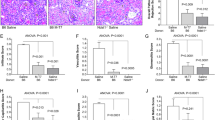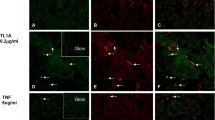Abstract
Background
There is increasing evidence showing that extracellular nucleotides may be important mediators of vascular inflammation. Nucleotide triphosphate diphosphohydrolase-1 (NTPDase-1, identical to CD39), the major vascular endothelial ectonucleotidase, is responsible for the hydrolysis of both extracellular ATP and ADP in the blood plasma to AMP. Studies were therefore conducted to evaluate the role of vascular NTPDase-1/cd39 in modulating platelet activation and vascular injury in cardiac xenografts.
Materials and Methods
Cardiac xenografts from both wild-type and cd39 knockout mice (C57BL/6 × 129 Svj) were transplanted into Lewis rats. Alterations in cd39 mRNA transcripts and NTPDase activity expression were evaluated in wild-type grafts in untreated rats and then following complement depletion and immunosuppression. Rejection responses were studied with both mutant and wild-type grafts in the following models: presensitization with or without complement depletion, complement depletion alone, and with chronic immunosuppression to induce long-term graft survival.
Results
NTPDase biochemical activity in wild-type xenografts rapidly decreased after transplantation but soon rebounded with graft survival. Elevated levels of cd39 mRNA with associated increases in NTPDase activity were observed in all long-term surviving wild-type grafts. Hyperacute xenograft rejection times were comparable in wild-type and mutant grafts but cd39-deficient grafts were subject to more rapid rejection and exhibited pronounced vascular injury in complement-depleted, presensitized rats. The cd39-deficient grafts in immunosuppressed recipients were subject to increased intravascular platelet sequestration and fibrin deposition; this resulted in focal myocardial infarction in long-term surviving mutant xenografts.
Conclusions
Augmentation of NTPDase-1 activity may be an important adaptive response for graft survival. Our results suggest that NTPDase-1/cd39 influences pathways of vascular injury in cardiac xenografts.









Similar content being viewed by others
References
Bach FH, Robson SC, Ferran C, et al. (1994) Endothelial cell activation and thromboregulation during xenograft rejection. Immunol Rev. 141: 5–30.
Robson SC, Candinas D, Hancock WW, Wrighton C, Winkler H, Bach FH. (1995) Role of endothelial cells in transplantation. Int. Arch. Allergy Immunol. 106: 305–322.
Bach FH, Winkler H, Ferran C, Hancock WW, Robson SC. (1996) Delayed xenograft rejection. Immunol. Today 17: 379–384.
Bach FH. (1998) Xenotransplantation: problems and prospects. Annu. Rev. Med. 49: 301–310.
Robson SC, Young VK, Cook NS, et al. (1996) Thrombin inhibition in an ex vivo model of porcine heart xenograft hyperacute rejection. Transplantation 61: 862–868.
Candinas D, Lesnikoski BA, Hancock WW, et al. (1996) Inhibition of platelet integrin GPIIbIIIa prolongs survival of discordant cardiac xenografts. Transplantation 62: 1–5.
Robson SC, Schulte am Esch II J, Bach FH. (1999) Factors in xenograft rejection. Ann. N.Y. Acad. Sci. 875: 261–276.
Kaczmarek E, Koziak K, Sevigny J, et al. (1996) Identification and characterization of CD39/vascular ATP diphosphohydrolase. J. Biol. Chem. 271: 33116–33122.
Cote YP, Picher M, St-Jean P, Beliveau R, Potier M, Beaudoin AR. (1991) Identification and localization of ATP-diphosphohydrolase (apyrase) in bovine aorta: relevance to vascular tone and platelet aggregation. Biochim. Biophys. Acta 1078: 187–191.
Luthje J. (1989) Origin, metabolism and function of extracellular adenine nucleotides in the blood. J. Klin. Wochenschr. 67: 317–327.
Plesner L. (1995) Ecto-ATPases: identities and functions. Int. Rev. Cytol. 158: 141–214.
Zimmermann H. (1992) 5′-Nucleotidase: molecular structure and functional aspects. Biochem. J. 285: 345–365.
Maliszewski CR, Delespesse GJ, Schoenborn MA, et al. (1994) The CD39 lymphoid cell activation antigen. Molecular cloning and structural characterization. J. Immunol. 153: 3574–3583.
Wang TF, Guidotti G. (1996) CD39 is an ecto-(Ca2+, Mg2+)-apyrase. J. Biol. Chem. 271: 9898–9901.
Marcus AJ, Safier LB, Hajjar KA, et al. (1991) Inhibition of platelet function by an aspirin-insensitive endothelial cell ADPase. Thromboregulation by endothelial cells. J. Clin. Invest. 88: 1690–1696.
Marcus AJ, Broekman MJ, Drosopoulos JH, et al. (1997) The endothelial cell ecto-ADPase responsible for inhibition of platelet function is CD39. J. Clin Invest. 99: 1351–1360.
Dubyak GR, el-Moatassim C. (1993) Signal transduction via P2-purinergic receptors for extracellular ATP and other nucleotides. Am. J. Physiol. 265: C577–C606.
Enjyoji K, Sévigny J, Lin Y, et al. (1999) Targeted disruption of cd39/ATP diphosphohydrolase results in disordered hemostasis and thromboregulation. Nat. Med. 5: 1010–1017.
Pearson JD, Gordon JL. (1979) Vascular endothelial and smooth muscle cells in culture selectively release adenine nucleotides. Nature 281: 384–386.
Motte S, Communi D, Pirotton S, Boeynaems JM. (1995) Involvement of multiple receptors in the actions of extracellular ATP: the example of vascular endothelial cells. Int. J. Biochem. Cell. Biol. 27: 1–7.
Di Virgilio F. (1995) The P2Z purinoceptor: an intriguing role in immunity, inflammation and cell death. Immunol. Today 16: 524–528.
Ferrari D, Chiozzi P, Falzoni S, et al. (1997) Extracellular ATP triggers IL-1 beta release by activating the purinergic P2Z receptor of human macrophages. J. Immunol. 159: 1451–1458.
Marcus AJ, Safier LB. (1993) Thromboregulation: multicellular modulation of platelet reactivity in hemostasis and thrombosis. FASEB J. 7: 516–522.
Chinellato A, Froldi G, Caparrotta L, Ragazzi E. (1998) Pharmacological characterization of endothelial cell nitric oxide synthase inhibitors in isolated rabbit aorta. Life Sci. 62: 479–490.
Simonsen U, Garcia-Sacristan A, Prieto D. (1997) Involvement of ATP in the non-adrenergic non-cholinergic inhibitory neurotransmission of lamb isolated coronary small arteries. Br. J. Pharmacol. 120: 411–420.
Rongen GA, Floras JS, Lenders JW, Thien T, Smits P. (1997) Cardiovascular pharmacology of purines [editorial]. Clin. Sci. (Colch.) 92: 13–24.
Bach FH, Robson SC, Winkler H, et al. (1995) Barriers to xenotransplantation [see comments]. Nat. Med. 1: 869–873.
Blakely ML, Van der Werf WJ, Berndt MC, Dalmasso AP, Bach FH, Hancock WW. (1994) Activation of intragraft endothelial and mononuclear cells during discordant xenograft rejection. Transplantation 58: 1059–1066.
Candinas D, Koyamada N, Miyatake T, et al. (1996) Loss of rat glomerular ATP diphosphohydrolase activity during reperfusion injury is associated with oxidative stress reactions. Thromb. Haemost. 76: 807–812.
Robson SC, Daoud S, Begin M, et al. (1997) Modulation of vascular ATP diphosphohydrolase by fatty acids. Blood Coagul. Fibrinolysis 8: 21–27.
Robson SC, Kaczmarek E, Siegel JB, et al. (1997) Loss of ATP diphosphohydrolase activity with endothelial cell activation. J. Exp. Med. 185: 153–163.
Robson SC, Siegel J, Candinas D, Kopp C, Bach FH. (1996) Loss of ATP diphosphohydrolase activity following endothelial cell activation. Transplant. Proc. 28: 536.
Bach FH, Ferran C, Hechenleitner P, et al. (1997) Accommodation of vascularized xenografts: expression of “protective genes” by donor endothelial cells in a host Th2 cytokine environment. Nat. Med. 3: 196–204.
Koyamada N, Miyatake T, Candinas D, et al. (1998) Transient complement inhibition plus T-cell immunosuppression induces long-term survival of mouse-to-rat cardiac xenografts. Transplantation 65: 1210–1215.
Sevigny J, Levesque FP, Grondin G, Beaudoin AR. (1997) Purification of the blood vessel ATP diphosphohydrolase, identification and localisation by immunological techniques. Biochim. Biophys. Acta 1334: 73–88.
Bradford MM. (1976) A rapid and sensitive method for the quantitation of microgram quantities of protein utilizing the principle of protein-dye binding. Anal. Biochem. 72: 248–254.
Baykov AA, Evtushenko OA, Avaeva SM. (1988) A malachite green procedure for orthophosphate determination and its use in alkaline phosphatase-based enzyme immunoassay. Anal. Biochem. 171: 266–270.
Imai M, Kaczmarek E, Koziak K, et al. (1999) Suppression of ATP diphosphohydrolase/CD39 in human vascular endothelial cells. Biochemistry 38: 13473–13479.
Schulte am Esch II J, Sévigny J, Kaczmarek E, et al. (1999) Structural elements and limited proteolysis of CD39 influence ATP diphosphohydrolase activity. Biochemistry 38: 2248–2258.
Koyamada N, Miyatake T, Candinas D, et al. (1996) Apyrase administration prolongs discordant xenograft survival. Transplantation 62: 1739–1743.
Imai M, Takigami K, Kaczmarek E, et al. (1999) CD39 gene transfer prolongs discordant xenograft survival. In: Abstracts: 5th Congress of the International Xenotransplantation Association 1999, Nagoya. Japanese Xenotransplantation Society, Nagoya, Japan.
Acknowledgments
Masato Imai and Ko Takigami contributed equally to this work. This study was supported in part by grants from National Institutes of Health HL 57307 (S.C.R.), PO1-41484 (R.D.R.) and American Heart Association GIA 9650490N. The authors are grateful to Elizbieta Kaczmarek and Christian Goepfert for expert assistance, as well as to members of our laboratory for discussion.
Author information
Authors and Affiliations
Corresponding author
Rights and permissions
About this article
Cite this article
Imai, M., Takigami, K., Guckelberger, O. et al. Modulation of Nucleotide Triphosphate Diphosphohydrolase-1 (NTPDase-1)/cd39 in Xenograft Rejection. Mol Med 5, 743–752 (1999). https://doi.org/10.1007/BF03402098
Accepted:
Published:
Issue Date:
DOI: https://doi.org/10.1007/BF03402098




